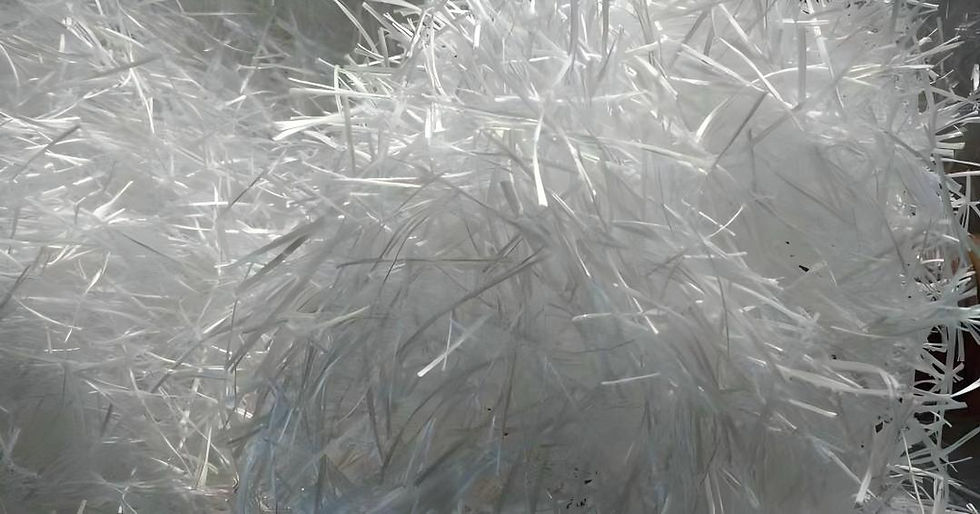How Macro Synthetic Fibers Improve Post-Crack Behavior in Concrete
- pioneerfiber

- 6 hours ago
- 3 min read
Suitable for architectural engineers, structural engineers, flooring contractors, precast component manufacturers, and technicians.
Concrete is strong in compression but inherently weak in tension. Once a crack forms, the material rapidly loses its ability to carry load—unless an internal reinforcement mechanism can bridge the crack and transfer stress. Macro synthetic fibers, such as HTM® Mono, are engineered specifically to enhance the post-crack behavior of concrete by forming a three-dimensional reinforcement network that engages after the concrete matrix fractures.
This article explains how macro fibers work, the engineering mechanisms behind their performance, and why they are increasingly used to replace traditional secondary reinforcement such as welded wire mesh (WWM) and steel fibers.

Why Post-Crack Performance Matters
While compressive strength is the primary indicator for concrete classification, post-crack performance determines how a structure behaves throughout its service life. Most engineering failures originate from:
Loss of tensile capacity after cracking
Insufficient load transfer across joints or cracks
Fatigue under repetitive loading
Impact damage and abrasion
Curling and warping from restrained shrinkage
Cracking and Load Transfer
Concrete cracks because the tensile strain exceeds its capacity—typically around 10% of its compressive strength. Without reinforcement, the crack immediately becomes a plane of weakness.
Macro fibers act as bridging elements that transfer load across the crack, maintaining structural integrity even after visible cracking.

How HTM® Mono Macro Synthetic Fibers Enhances Post-Crack Strength
Macro synthetic fibers such as HTM® Mono provide superior post-crack behavior due to three key engineering mechanisms.
1. 3D Reinforcement Network
When mixed into concrete, HTM® Mono distributes in a uniform, multi-directional pattern. Unlike steel mesh, which reinforces only one plane, macro fibers reinforce the entire volume of the slab.
This provides:
Multi-directional crack bridging
Load transfer regardless of crack orientation
Reduced crack widening
Better distribution of stresses
2. Mechanical Bonding & Pull-Out Resistance
Fiber geometry determines the efficiency of post-crack load transfer.
HTM® Mono is engineered with:
High-strength monofilament structure
Surface embossing for enhanced mechanical interlock
High tensile strength
High modulus polymer backbone
The result is high pull-out resistance—the fiber grips the concrete matrix tightly, absorbing energy as it slides out.
3. Residual Strength Improvement
Residual strength (fR, ASTM C1609 / EN 14651) is the most important parameter for evaluating macro fiber performance.
HTM® Mono contributes to:
Higher fR1 (serviceability)
Higher fR3 (ultimate load resistance)
Improved ductility after cracking
Increased toughness index
This is why HTM® Mono is widely used in industrial floors, foundations, pavements, and precast concrete elements.

Test Data & Real-World Performance
Project data consistently show that macro synthetic fibers improve:
Crack width control
Fatigue resistance
Impact energy absorption
Joint stability
Long-term slab performance
Macro fibers are particularly effective in:
Warehouse slabs-on-ground
Logistics centers
Industrial pavements
Heavy-load slabs
Container yards
In these applications, WWM and steel fibers are increasingly replaced, reducing cost while improving ductility.
Recommended Dosage for Post-Crack Requirements
Typical dosage for macro synthetic fibers:
Performance Level | Typical Dosage |
Shrinkage control | 2.5–3.0 kg/m³ |
Structural floors | 4.0–6.0 kg/m³ |
Heavy-duty slabs | 6.0–8.0 kg/m³ |
HTM® Mono dosage should be selected based on residual strength requirements, not compressive strength.
Conclusion
Macro synthetic fibers such as HTM® Mono transform traditional concrete into a ductile, high-performance composite. Their ability to enhance post-crack behavior makes them an effective alternative to welded wire mesh and steel fibers in many flooring and pavement applications.





Comments